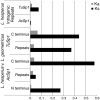Ancient properties of spider silks revealed by the complete gene sequence of the prey-wrapping silk protein (AcSp1)
- PMID: 23155003
- PMCID: PMC3563967
- DOI: 10.1093/molbev/mss254
Ancient properties of spider silks revealed by the complete gene sequence of the prey-wrapping silk protein (AcSp1)
Abstract
Spider silk fibers have impressive mechanical properties and are primarily composed of highly repetitive structural proteins (termed spidroins) encoded by a single gene family. Most characterized spidroin genes are incompletely known because of their extreme size (typically >9 kb) and repetitiveness, limiting understanding of the evolutionary processes that gave rise to their unusual gene architectures. The only complete spidroin genes characterized thus far form the dragline in the Western black widow, Latrodectus hesperus. Here, we describe the first complete gene sequence encoding the aciniform spidroin AcSp1, the primary component of spider prey-wrapping fibers. L. hesperus AcSp1 contains a single enormous (∼19 kb) exon. The AcSp1 repeat sequence is exceptionally conserved between two widow species (∼94% identity) and between widows and distantly related orb-weavers (∼30% identity), consistent with a history of strong purifying selection on its amino acid sequence. Furthermore, the 16 repeats (each 371-375 amino acids long) found in black widow AcSp1 are, on average, >99% identical at the nucleotide level. A combination of stabilizing selection on amino acid sequence, selection on silent sites, and intragenic recombination likely explains the extreme homogenization of AcSp1 repeats. In addition, phylogenetic analyses of spidroin paralogs support a gene duplication event occurring concomitantly with specialization of the aciniform glands and the tubuliform glands, which synthesize egg-case silk. With repeats that are dramatically different in length and amino acid composition from dragline spidroins, our L. hesperus AcSp1 expands the knowledge base for developing silk-based biomimetic technologies.
Figures





Similar articles
-
Intragenic homogenization and multiple copies of prey-wrapping silk genes in Argiope garden spiders.BMC Evol Biol. 2014 Feb 20;14:31. doi: 10.1186/1471-2148-14-31. BMC Evol Biol. 2014. PMID: 24552485 Free PMC article.
-
Aciniform spidroin, a constituent of egg case sacs and wrapping silk fibers from the black widow spider Latrodectus hesperus.J Biol Chem. 2007 Nov 30;282(48):35088-97. doi: 10.1074/jbc.M705791200. Epub 2007 Oct 5. J Biol Chem. 2007. PMID: 17921147
-
Complex gene expression in the dragline silk producing glands of the Western black widow (Latrodectus hesperus).BMC Genomics. 2013 Dec 2;14:846. doi: 10.1186/1471-2164-14-846. BMC Genomics. 2013. PMID: 24295234 Free PMC article.
-
The three novel complete aciniform spidroin variants from Araneus ventricosus reveal diversity of gene sequences within specific spidroin type.Int J Biol Macromol. 2020 Aug 15;157:60-66. doi: 10.1016/j.ijbiomac.2020.04.142. Epub 2020 Apr 24. Int J Biol Macromol. 2020. PMID: 32335120
-
Native Silk Fibers: Protein Sequence and Structure Influences on Thermal and Mechanical Properties.Biomacromolecules. 2025 Apr 14;26(4):2043-2059. doi: 10.1021/acs.biomac.4c01781. Epub 2025 Mar 7. Biomacromolecules. 2025. PMID: 40052735 Review.
Cited by
-
Characterization of the genome and silk-gland transcriptomes of Darwin's bark spider (Caerostris darwini).PLoS One. 2022 Jun 6;17(6):e0268660. doi: 10.1371/journal.pone.0268660. eCollection 2022. PLoS One. 2022. PMID: 35666730 Free PMC article.
-
The evolutionary history of cribellate orb-weaver capture thread spidroins.BMC Ecol Evol. 2022 Jul 9;22(1):89. doi: 10.1186/s12862-022-02042-5. BMC Ecol Evol. 2022. PMID: 35810286 Free PMC article.
-
Toward Spider Glue: Long Read Scaffolding for Extreme Length and Repetitious Silk Family Genes AgSp1 and AgSp2 with Insights into Functional Adaptation.G3 (Bethesda). 2019 Jun 5;9(6):1909-1919. doi: 10.1534/g3.119.400065. G3 (Bethesda). 2019. PMID: 30975702 Free PMC article.
-
Mosaic evolution of silk genes in Aliatypus trapdoor spiders (mygalomorphae, antrodiaetidae).J Mol Evol. 2013 Apr;76(4):216-27. doi: 10.1007/s00239-013-9550-7. Epub 2013 Mar 16. J Mol Evol. 2013. PMID: 23503815
-
Evolutionary shifts in gene expression decoupled from gene duplication across functionally distinct spider silk glands.Sci Rep. 2017 Aug 21;7(1):8393. doi: 10.1038/s41598-017-07388-1. Sci Rep. 2017. PMID: 28827773 Free PMC article.
References
-
- Abascal F, Zardoya R, Posada D. ProtTest: selection of best-fit models of protein evolution. Bioinformatics. 2005;21:2104–2105. - PubMed
-
- Altschul SF, Gish W, Miller W, Myers EW, Lipman DJ. Basic local alignment search tool. J Mol Biol. 1990;215:403–410. - PubMed
-
- Askarieh G, Hedhammar M, Nordling K, Saenz A, Casals C, Rising A, Johansson J, Knight SD. Self-assembly of spider silk proteins is controlled by a pH-sensitive relay. Nature. 2010;465:236–238. - PubMed
-
- Ayoub NA, Hayashi CY. Multiple recombining loci encode MaSp1, the primary constituent of dragline silk, in widow spiders (Latrodectus: Theridiidae) Mol Biol Evol. 2008;25:277–286. - PubMed
Publication types
MeSH terms
Substances
Associated data
- Actions
- Actions
- Actions
- Actions
- Actions
- Actions
- Actions
- Actions
- Actions
- Actions
- Actions
- Actions
- Actions

